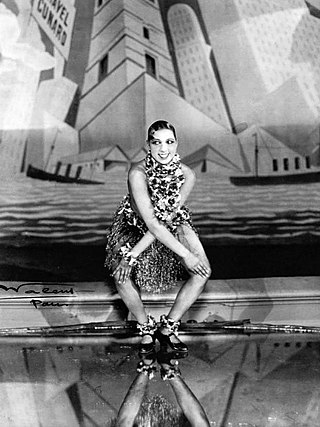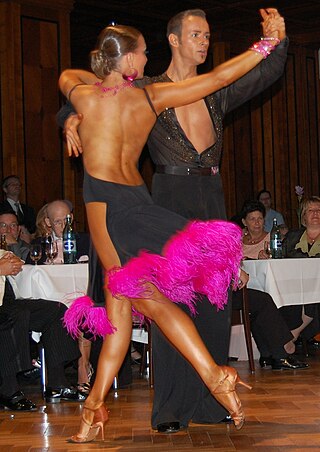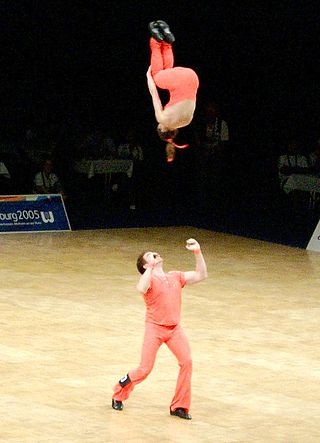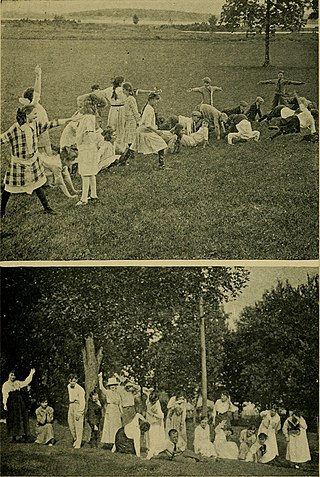
Ballroom dance is a set of European partner dances, which are enjoyed both socially and competitively around the world, mostly because of its performance and entertainment aspects. Ballroom dancing is also widely enjoyed on stage, film, and television.
In some types of partner dance, lead and follow are designations for the two dancers' roles in a dance pairing. The leader is responsible for guiding the couple and initiating transitions to different dance steps and, in improvised dances, for choosing the dance steps to perform. The leader communicates choices to the follower, and directs the follower by means of subtle physical and visual signals, thereby allowing the pair to be smoothly coordinated.

The Charleston is a dance named after the harbor city of Charleston, South Carolina. The rhythm was popularized in mainstream dance music in the United States by a 1923 tune called "The Charleston" by composer/pianist James P. Johnson, which originated in the Broadway show Runnin' Wild and became one of the most popular hits of the decade. Runnin' Wild ran from 28 October 1923 through 28 June 1924. The Charleston dance's peak popularity occurred from mid-1926 to 1927.

Swing dance is a group of social dances that developed with the swing style of jazz music in the 1920s–1940s, with the origins of each dance predating the popular "swing era". Hundreds of styles of swing dancing were developed; those that have survived beyond that era include Charleston, Balboa, Lindy Hop, and Collegiate Shag. Today, the best-known of these dances is the Lindy Hop, which originated in Harlem in the early 1930s. While the majority of swing dances began in African-American communities as vernacular African-American dances, some influenced swing-era dances, like Balboa, developed outside of these communities.

The Shim Sham Shimmy,Shim Sham or just Sham originally is a particular tap dance routine and is regarded as tap dance's national anthem. For today's swing dancers, it is a line dance.

Partner dances are dances whose basic choreography involves coordinated dancing of two partners, as opposed to individuals dancing alone or individually in a non-coordinated manner, and as opposed to groups of people dancing simultaneously in a coordinated manner.
This is a list of dance terms that are not names of dances or types of dances. See List of dances and List of dance style categories for those.
Dance improvisation is the process of spontaneously creating movement. Development of movement material is facilitated through a variety of creative explorations including body mapping through levels, shape and dynamics schema.

Boogie-woogie dance is a European variation of swing dance often done competitively that developed in the 1940s. Although its name derives from the boogie-woogie genre of music, it is most often danced to rock music. The form is cited in Madonna's hit single "Music"
Swing! is a musical conceived by Paul Kelly with music by various artists. It celebrates the music of the Swing era of jazz (1930s–1946), including many well-known tunes by artists like Duke Ellington, William "Count" Basie, Benny Goodman and others. It received a nomination for the 2000 Tony Award for Best Musical and other Tony awards.

Acrobatic rock and roll is a fast, athletic, physically demanding form of partner dance that originated from Lindy Hop but has evolved to a choreographed sport, often done in formal competition. It is danced by both couples and groups, either all-female or four to eight couples together.
Jamming in dance culture is a kind of informal show-off during a social dance party. Dancers clear a circle and dancers or dance couples take turns showing their best tricks while the remaining dancers cheer the jammers on. While some jam circles are staged, most form organically and spontaneously when the energy and mood is right.
Sylvia Sykes is an American swing dancer, instructor, judge, and choreographer. She is known for reviving the swing dance style balboa.

A show choir is a musical ensemble that combines choral singing with choreographed dance, often integrated into a narrative story. Show choirs have been popularized by the American television show Glee but have a longer history dating back to glee clubs in London in the 18th century, musical theatre, music in the plays of William Shakespeare and the theatre of ancient Greece.

Dmitry Chaplin is a Russian dancer, choreographer, and actor, best known for being a Top 10 finalist on the second season of the dance competition series So You Think You Can Dance. While competing on the series, he became known for performing shirtless, with one solo routine having him rip off his shirt. In 2009, Chaplin was nominated for a Primetime Emmy Award for his choreography.

A mixer dance, dance mixer or simply mixer is a kind of participation dance in a social dance setting that involves changing partners as an integral part. Mixing can be built into the dance choreography or can be structured to occur more randomly. Mixers allow dancers to meet new partners and allow beginners to dance with more advanced dancers. Some people may take advantage of mixers to assess dance skills of other persons without fear of being stuck with a poor match for an entire dance.
So You Think You Can Dance is an American reality television program and dance competition airing on the Fox network. Season three premiered May 24, 2007.

You Can Dance – Po prostu tańcz! is a televised Polish dance competition with a format based on the American show So You Think You Can Dance. Dancers compete to win PLN 100,000, and a 3-month scholarship in dance school Broadway Dance Center and International Dance Academy in Los Angeles from season 7 on. The winners to date are : Maciek "Gleba" Florek, Artur Cieciórski, Wiola Fiuk, Ania Kapera, Jakub Jóżwiak, Dominik Olechowski, Brian Poniatowski, Mateusz Sobecko and Stefano Silvino.
Katya Virshilas is a Lithuanian-Canadian dancer and actress.
The rhythm dance (RD) is the first segment of an ice dance competition. The International Skating Union (ISU) renamed the short dance to the "rhythm dance" in June 2018, prior to the 2018–2019 season. It became part of international competitions in July 2018. French ice dancers Gabriella Papadakis and Guillaume Cizeron hold the highest RD score of 90.83 points, which they achieved at the 2022 Beijing Winter Olympics.










